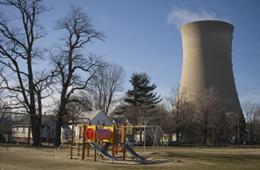 Does proximity to nuclear power plants raise leukaemia risk? COMARE says no.Venture Media Group/Aurora Photos/Corbis
Does proximity to nuclear power plants raise leukaemia risk? COMARE says no.Venture Media Group/Aurora Photos/CorbisLiving close to a nuclear power station does not increase a child's risk of developing leukaemia, according to one of the most detailed studies of the issue to date.
The latest report from the UK's Committee on Medical Aspects of Radiation in the Environment (COMARE), published today, calls into question the findings of an influential study in Germany which claimed that clusters of leukaemia cases were more likely to be found near nuclear plants.
Alex Elliott, chair of COMARE and a clinical physicist at the University of Glasgow, UK, says that researchers should now look for other causes of these leukaemia clusters.
Nuclear sites have long been plagued by allegations that they release sufficient low-level radiation to raise the risk of childhood cancers. Despite sparse evidence to support the hypothesis, public concerns have persisted.
The latest report from COMARE looks specifically at the incidence of this cancer in children under the age of 5 living near 13 of the UK's nuclear power plants. It found "no significant association", says Elliott.
Roughly 500 children in the United Kingdom are diagnosed with leukaemia in any given year, and over the entire study period of 35 years there were only 20 cases in children under 5 years of age within 5 kilometres of a power plant. "It's something that's very difficult to study statistically," admits Elliott.
As the numbers involved in this are tiny, it is possible that there could be an effect too small to measure, but this effect would itself be tiny in consequence, the authors say.
The COMARE report contrasts with a German study called Kinderkrebs in der Umgebung von Kernkraftwerken (KiKK; Childhood cancer in the vicinity of nuclear power plants). In 2008, the KiKK team reported1that living within 5 kilometres of a nuclear power plant in Germany roughly doubled the risk of childhood leukaemia.
COMARE's latest report includes a critique of the KiKK study, pointing out that it did not fully assess confounding factors other than radiation, which may have been partly responsible for the association. In leukaemia, Elliott notes, there are known to be correlations between the disease and socioeconomic status and population density, for example. COMARE attempted to compensate for these and other issues, but the KiKK study did not. "If there was an effect like the KiKK study [in the UK] we would have found it and we didn't," says Elliott. Nature was unable to obtain comment from the KiKK team.
Cluster causes
The COMARE report also looked at leukaemia cases at several sites that had been proposed as locations for nuclear power plants that were never actually built. There was a small increase in childhood leukaemia cases within 5 kilometres of one of the proposed power plants, which may highlight the dangers of apparently statistically robust results occurring by chance when dealing with such rare diseases. Or, the report notes, it could mean that sites suitable for nuclear power plants have some characteristic which can also increase the risk of leukaemia.
Not everyone is convinced that the COMARE report settles the issue. Steve Wing, an epidemiologist at the University of North Carolina at Chapel Hill, says that studies to date have not been properly designed to detect any effect from the very low radiation doses that people living near nuclear plants may be exposed to. But a US team is now preparing to update a 1990 study on the link between nuclear power stations and cancer cases at the request of the US Nuclear Regulatory Commission (see 'US radiation study sparks debate'). Wing suggests that the US study could provide a more effective analysis by assessing the radiation doses that are received in utero and in early childhood by those living close to nuclear plants2.
ADVERTISEMENT
Others say there are alternative explanations for leukaemia clusters, such as the possibility of an infectious agent being responsible for triggering leukaemia.
Leo Kinlen, an epidemiologist based at the University of Oxford, UK, has long argued that sites such as nuclear power stations and military bases may be more likely to host leukaemia clusters because of the relatively high population turnover in those areas. Population mixing would increase people's exposure to novel viruses to which they had no immunity, potentially raising the risk of related illnesses, he says.
Mel Greaves, team leader in the biology of childhood leukaemia at the Institute of Cancer Research in Sutton, UK, instead suggests that the cases may arise from an abnormal immune response to common infections, rather than a specific virus. "I think the consensus view is that it's something to do with timing of exposure to infection," he says.
-
References
- Kaatsch, P. et al. Int. J. Cancer 1220, 721-726 (2008).
- Wing, S., Richardson, D. & Hoffmann, W. Environ. Health Perspect.119, 1-5 (2011). | PubMed |

